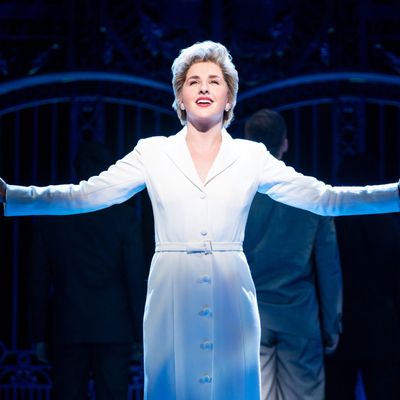
I’m old enough that I don’t just remember when Diana Spencer died, I remember when she was married. I was little-ish, and my mother had somehow acquired a luxe program-style booklet about the wedding, which contained extreme levels of detail about the enormous dress, the flower girls’ headdresses, the veil. And sitting there under our Kansas dining-room table looking at pages of pretty princess pictures, I came to one of the most useful realizations of my young life: I get it, I thought, rich people don’t have taste.
A costume parade disguised as a terrible Broadway musical rings that gong as well. It doesn’t come as a surprise that the pop-rock Diana: The Musical is (deliberately?) bad — Netflix filmed it during the shutdown, so there’s been plenty of opportunity for interested folks to test run it on their laptops. Maybe you’ve seen the gif of a topless James Hewitt (Gareth Keegan) rising up through the floor on a saddle, or Diana (Jeanna de Waal) singing about how much she wishes Prince Charles (Roe Hartrampf) would listen to hipper music. “Perhaps this girl can turn him into a rocker!” Diana cries, bored at a cello concert, as the ensemble does aggressive shrug-dancing all around her.
It’s hard to know whether it was wise of the producers to release the film. On the bright side, it ensures they have a prepared audience, ready for lyrics like “So how about this fuck you dress / this fuckity-fuckity-fuckity-fuckity fuck you dress.” On the bleak side, it means that savage reviews predate their Broadway opening night. And, look, cheesy is fine; goofy fake accents are no problem. There are a dozen quick changes for Diana that even add a little merriment. (William Ivey Long did the costumes, though he has since parted ways with the production.) The trouble lies in the show’s faltering execution. For instance, designer David Zinn has built the show a lovely Buckingham Palace, repeating the gilt folderol of the Longacre Theatre’s proscenium on the columns and gates that enclose the stage. But as director Christopher Ashley sends the columns gliding hither and thither to create various interiors and exteriors, the structures often … wobble. A scene might already be in motion — Diana is phoning a journalist or whatever — and a ten-foot-tall column will come sneaking up behind her, giving a little hiccup as it settles into place. Has the palace wall been drinking? one wonders. Certainly it’s late to work.
Speaking of day drinking, the best Diana can hope for is that its tackiness will transform, through the magic of mess-addicted theatergoers, into a sort of warmly accepted kitsch. The show’s social-media account has been encouraging people to have wine beforehand, cheering “here for a good time not a long time!” There’s plenty of evidence that the show’s creators Joe DiPietro and David Bryan are going for a kind of late-night extended-SNL-sketch vibe, with Diana singing things like “serves me right for marrying a Scorpio,” which point at (but never achieve) camp. Camp should be possible. We have an appetite for the humiliations of the British royals — in another theater on Broadway, Six parades a rather earlier chain of such embarrassments, and people are lapping it up. Even in the bare facts, there’s plenty of absurdity to mine: Diana’s doing a dance at the Royal Opera House to impress her horrified husband; the couple’s infidelities with Hewitt and Camilla Parker Bowles (Erin Davie) playing out in public; the outfits.
What prevents the show from ascending into joyous camp, though, are its dullness and repetition. DiPietro and composer Bryan see their story as a drama of only four people: Diana, Charles, Camilla, and the Queen (Judy Kaye). It’s hard to watch this square rotate for more than two hours. Sons are born but do not appear (except as bundles, briefly); the queen has no husband, no other children, no advisors, no prime minister. The music, though, is what really saws at you. Metrically, the songs seem to have only one idea. Nearly every line is five or six syllables long; the melodies are interchangeable. This sameness proves, over time, to be difficult to bear. The last song in the first act, which is meant to propel us into intermission, has this as its chorus:
A pretty pretty girl
In a pretty pretty dress
A pretty pretty girl
In a pretty pretty dress.
This was repeated many many times, till I was a total total mess. Also, the only way to convey emotion in such an arid musical landscape is to move up a key, so poor de Waal is stuck on an infinitely modulating escalator to nowhere. This drives loveliness out of her tone—the show is long, and there’s only one persistent, rather unpleasant vocal sound that can climb it.
Okay, okay, so it’s bad. But unfortunately, in the second act, it turns sort of gross, too. Anyone who knows the outline of Diana Spencer’s life knows that eventually we’re going to have to go to the AIDS clinic. Diana was a savvy curator of her own image: She grasped the proto-influencer nature of the royal family early in the game. There were a few ways that she used this power for unalloyed good, including a famous incident when she shook hands — without wearing gloves — with HIV-positive patients. Unfortunately, by the time de Waal walks into that hospital set (a column lumbers guiltily off to the left), the show has already tipped very far into parody. The same ensemble that played the paparazzi in fedoras and trenchcoats, whooshing their coattails like extras from Dance of the Vampires, simply cannot pivot to playing pale-faced, shuddering AIDS patients. It can be jolly to indulge in tastelessness, don’t you know? At least right up until the moment that it’s not.
Diana: The Musical is at the Longacre Theatre.


